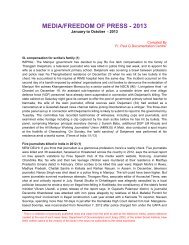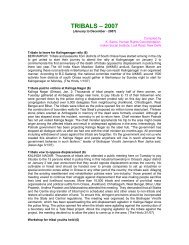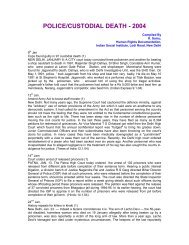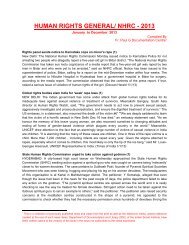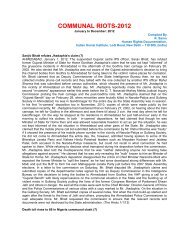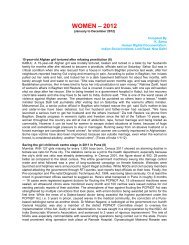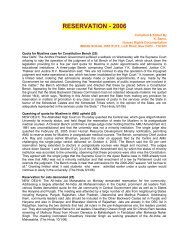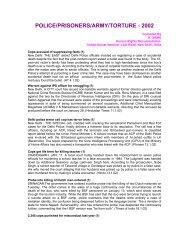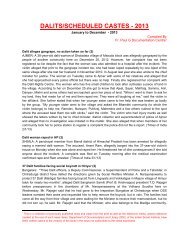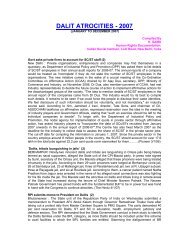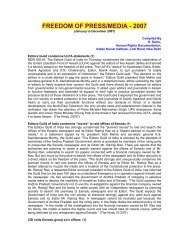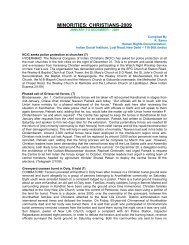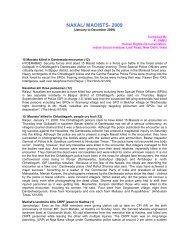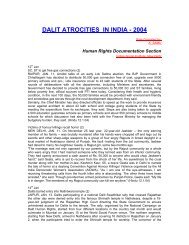You also want an ePaper? Increase the reach of your titles
YUMPU automatically turns print PDFs into web optimized ePapers that Google loves.
Sheela who ekes out a living as a housemaid. Her sentiments were echoed by another housemaid Gudia.<br />
She said. "My son does not ask for food once he has had handia." A large family coupled with a low<br />
income also makes life difficult for these indigent workers.. "I earn Rs 1,200 per month. I have four<br />
children and it is difficult to serve even two meals a day," Gudia adds. Poverty and occasional employment<br />
makes the life of these poor people very harsh. In Jharkhand 52 per cent of the population live Below<br />
Poverty Line (BPL). Labourers are often forced to migrate to other states in search of jobs. Those left<br />
behind are often without employment. The consumption of handia, however, has socio-economic<br />
sanction." Firstly, handia is inextricably associated with the tribal culture. It is used even in prayer. And<br />
secondly, it's the poverty. We cannot separate both the points," said VS Upadhyaya, an anthropologist.<br />
(Pioneer 2/12/05)<br />
Cabinet nod to Tribal Bill, no clear winners (6)<br />
NEW DELHI, DEC 1: The Cabinet today cleared the Scheduled Tribes (Recognition of Forest Rights) Bill<br />
but neither the Environment Ministry nor the Tribals Affairs Ministry have emerged clear winners. The Bill<br />
seeks to give temporary land rights to tribals living in wildlife sanctuaries and national parks. But to the<br />
delight of wildlife activists, the Forest Department has been given five years to relocate them. Failure to do<br />
so within this period would ensure tribals get permanent pattas over their piece of sanctuary land. The<br />
Environment Ministry had wanted these protected wildlife sanctuaries to be kept outside the Bill’s ambit<br />
while the Tribal Affairs Ministry wanted permanent land rights to be granted. Today’s compromise paves<br />
the way for the Bill to be introduced in the winter session of Parliament itself. “The sanctuaries will be<br />
protected... the environment and revenue officers will take care that the Bill is implemented in its spirit,”<br />
Environment Minister A Raja said. The settlement of tribals inside sanctuaries had led to controversy. In<br />
the first bill prepared by the Tribals Affairs Ministry, permanent land rights were bestowed on tribals in<br />
sanctuaries, angering tiger activists. After a long battle that necessitated Prime Minister Manmohan<br />
Singh’s intervention, the two ministries tried to hammer out a middle path. Sources in the Environment and<br />
Forests Ministry said tribals who live in core sanctuary areas will be relocated. Relocating all tribals in<br />
sanctuaries might be impossible. Another new provision incorporated at the Environment Ministry’s behest<br />
is that the cut-off date for recognising the tribals’ rights has been set as October 25, 1980 — the date the<br />
Forest Conservation Act came into being. In the original Tribal Affairs Ministry bill, the date was flexible.<br />
(<strong>Indian</strong> Express 2/12/05)<br />
A.P. Minister promises fair deal for affected tribals (6)<br />
HYDERABAD: Andhra Pradesh Ma jor Irrigation Minister Ponnala Lakshmaiah has promised the best<br />
resettlement and rehabil itation package for affected trib als under the Polavaram irrigation project. "Any<br />
decision on rehabilita tion and compensation will be taken only after the consent of displaced people,<br />
particularly tribals," Mr. Lakshmaiah told re porters after a lengthy three-hour-long meeting with Narma-da<br />
Bachao Andolan chief organiser Medha Patkar at the Secretariat here on Sunday. "There will be no<br />
harassment of villagers by the police," he said. It was the first meeting be tween the Minister and the so cial<br />
activist and representatives of the Solidarity Committee for Anti-Polavaram Agitation and both sides<br />
expressing their views on the project. Ms. Patkar was here on the Minister's in vitation. Responding to a<br />
question from activists, Irrigation Secre tary Satish Chandra said the Central Water Commission had given<br />
clearance in principle and the final nod was awaited. Ms. Patkar said without getting all clearances it was<br />
not ideal to go ahead with the project and re ferred to ongoing canal works. She also quizzed the Minister<br />
about the funding pattern, R&R package and alleged harassment of villagers by the police. She in sisted<br />
that revenue teams should extensively tour villages and in teract with people before finalis ing the<br />
compensation package. Statistics on the number of fam ilies to be displaced was not in tune with those<br />
gathered by peo ple's organisations. (The Hindu 5/12/05)<br />
Silica disease hits tribals in Godhra stone crushing units (6)<br />
JOJ VILLAGE (VADODARA), DECEMBER 6 : FORTY-YEAR-OLD Raman Bhagwania Nayaka and his<br />
wife Devaliben, who worked in a stone-crushing factory at Godhra, are lying critically ill at their home in<br />
Guda village in Chhotaudepur, Vadodara, complaining of severe respira tory trouble, frequent bouts of<br />
coughing and weakness. Four members of a family from the same village, the Nayakas—Bhailalbhai,<br />
Popat, Nakat and Ramesh—did not survive. Neither did Andariab-hai Galia and his two wives, Ramilaben<br />
and Amliben. All of them worked at a stone-crushing unit in Godhra. The villagers say a total of 43 tribals<br />
from the village have died in the past three years, all due to pulmonary infections. All of them reportedly



